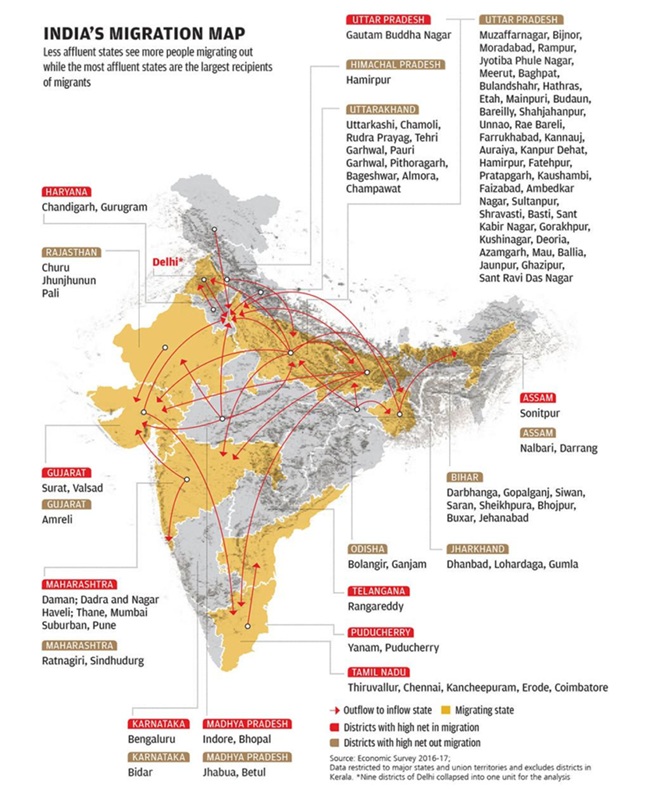Prelims: (Society + CA)
Mains: (GS 1 – Society, GS 2 – Governance, GS 3 – Economy) |
Why in the News?
The Ministry of Statistics and Programme Implementation (MoSPI) has announced a year-long National Migration Survey to be conducted from July 2026 to June 2027. The aim is to generate updated and comprehensive data on internal migration in India. A draft questionnaire and concept note have been released for public feedback until 30 November 2025.

Background: Migration in India
Migration refers to the movement of people from one region to another for reasons such as employment, marriage, education, climate pressures, or improved living standards.
Key Statistics (PLFS 2020–21)
- 28.9% of India’s population are migrants.
- Female migration (48% in rural areas) is predominantly due to marriage.
- Male migration is mainly employment-driven (67%).
- Major migration flows:
- Rural → Urban (jobs & education)
- Inter-state migration from Bihar, UP, Odisha → Delhi, Maharashtra, Gujarat
Why This Data Matters?
Migration influences:
- Urbanisation
- Labour markets & industrial growth
- Remittance-based rural economies
- Housing & social security policies
Challenges in Migration Management
- Informal employment
- Poor housing & slum clusters
- Lack of portability of welfare schemes
- Post-pandemic reverse migration patterns
About the National Migration Survey 2026
Conducting Agency
- National Sample Survey Office (NSSO) under MoSPI
- Part of India’s socio-economic survey architecture since 1950
Coverage
- Nearly all States & Union Territories
- Andaman & Nicobar Islands excluded due to logistical constraints
Objectives
- Estimate migration rates & flows (rural–urban, interstate, intrastate)
- Capture short-term, seasonal, and return migration
- Identify drivers of migration
- Record employment, income, and living standards
- Assess impacts on households, communities, remittances, welfare access
Evolution of Migration Surveys in India
|
Year / NSS Round
|
Key Features
|
|
1955 (9th Round)
|
First attempts at migration data collection
|
|
1963–64 (18th Round)
|
Early dedicated migration study
|
|
2007–08 (64th Round)
|
Last full migration survey; now outdated
|
|
2020–21
|
PLFS captured limited migration data (28.9%)
|
|
2020–21
|
Multiple Indicator Survey – limited mobility insights
|
Why a New Survey Now?
- No dedicated survey for 18 years
- COVID-19 caused reverse migration & socio-economic shocks
- Need for granular, real-time, individual-level data
Key Features of the 2026 Survey
1. Revised Definitions
- Short-term migrant: Person staying away for 15 days to 6 months for employment or job search
- Shift from household-level to individual-level migration tracking
2. Broader & Deeper Data Capture
New additions include:
- Income/occupation changes after migration
- Access to healthcare, education, food, housing
- Integration & living conditions at destinations
- Future migration intent
- Issues of harassment, discrimination, identity proof access
3. Policy Integration Focus
The survey will support policymaking in:
Urban Development
- Housing planning, transport policy, slum rehabilitation
Employment Generation
- Mapping labour shortages & skill mobility
Social Protection
- Improving portability under ONORC, ESIC, PF, welfare schemes
Regional Development
- Understanding remittances & rural livelihood diversification
Why is the Survey Significant? (Analytical)
1. Critical Post-Pandemic Need
COVID-19 exposed:
- Weak labour records
- Poor welfare portability
- Vulnerability of seasonal migrants
The survey fills a major data vacuum.
2. Supports Sustainable Urbanisation
Better data will improve:
- City planning
- Affordable housing
- Transport design
- Inclusive development
3. Economic Impact Assessment
Helps evaluate:
- Productivity
- Skill migration
- State-level labour profiles
- Remittance-driven rural consumption
4. Helps Address Social Issues
Migration links to:
- Child labour
- Women’s safety
- Access to health & education
- Identity/documentation gaps
Issues & Challenges in Migration Management
- Absence of a national migration registry
- Fragmented databases
- Weak inter-state coordination
- Exclusion from welfare schemes
- Informal urban housing
- Gendered vulnerability (domestic work, unpaid labour)
|
FAQs
1. Why is the National Migration Survey 2026 important?
It will provide updated, detailed, and individual-level migration data—critical after COVID-19 disrupted traditional migration patterns.
2. Who will conduct the survey?
The National Sample Survey Office (NSSO) under MoSPI.
3. What new elements will the survey capture?
Income shifts, access to services, discrimination, integration at destinations, and short-term migration patterns.
4. When was the last full migration survey conducted?
In 2007–08 (NSS 64th Round).
5. Why is migration data essential for policy?
It helps design policies for housing, welfare portability, labour markets, transport, and urban planning.
|


